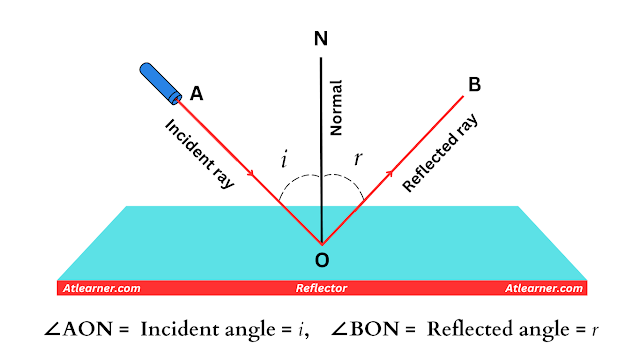🤔 Have you ever wondered why we can see our image in a flat mirror?
It happens because of the reflection of light. Light has several properties, reflection is one of them. For this reflection, we are able to see the different objects around us. So in today's lesson, we are going to explore the reflection property of light in detail.
Reflection of Light
When a beam of light is incident on a surface, a part of it is returned to the same medium. The return of light into the same medium after striking the surface is called reflection. The remaining part of the light is either absorbed or partly transmitted through the medium.
Definition: When light rays fall on a smooth surface (or a reflector) and return to the same medium, then the phenomenon is called the reflection of light.
The surface from which light is reflected is called a reflector. The ray that falls on the reflector is called the incident ray. The ray that bounces back from the reflector is called the reflected ray.
The point where the light ray hits the reflector is called the point of incidence. If we draw a perpendicular on that, then it would be called the normal.
The geometric figure given below shows the reflection of a laser beam of light in a plane mirror.
Now let's understand the laws of reflection...
Laws of Reflection
Wherever reflection occurs on a surface, it obeys two laws, called the laws of reflection.
(ⅰ) The angle of incidence is always equal to the angle of reflection.
(ⅰⅰ) The incident ray, the reflected ray, and the normal at the point of incidence, all lie in the same plane.
Here, the angle of incidence (i) is the angle between the incident ray and the normal. And the angle of reflection (r) is the angle between the reflected ray and the normal.
Types of Reflection
There are usually two types of reflection - regular reflection and irregular reflection. Here is a brief discussion about them.
• Regular Reflection:
When a parallel beam of light rays is incident on a smooth and polished surface, the reflected beam is also parallel and is in a fixed direction. This type of reflection is known as regular reflection or specular reflection.
This reflection only occurs when a beam of light falls on a smooth and polished surface (like a mirror). For this regular reflection, we can see our clear image in the mirror.
• Irregular Reflection:
When a parallel beam of light rays is incident on a rough and non-polished surface, the reflected rays are not parallel they are reflected in different directions. This type of reflection is known as irregular reflection or diffused reflection.
This reflection occurs when a beam of light falls on a rough and non-polished surface (like a wall, wood, paper, etc). In irregular reflection, we can't see image formation.



Post a Comment (0)